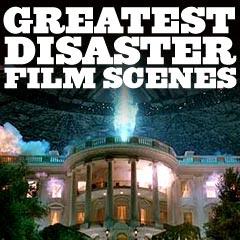
|
Film Scenes 1980s |


|
This tongue-in-cheek movie was probably the best disaster film spoof ever made, and one of the surprise comedy hits of all-time by The Kentucky Fried Movie (1977) trio of writers: David and Jerry Zucker and Jim Abrahams. [Note: In that earlier film, they lampooned the entire Irwin Allen disaster genre with a hilarious preview trailer for the disaster film That's Armageddon.] This low-brow effort was filled with rapid-fire quips, sight gags, and some clever double entendres. It parodied both Zero Hour! (1957) (from which it took plot and characters) and the various subplots from the Airport films of the previous decade (most notably Airport '75 (1974)'s girl-needing-heart transplant subplot with a guitar-playing nun). The superficial, juvenile plot was about a Boeing 707 passenger flight from Los Angeles to Chicago, piloted by Captain Clarence Oveur (Peter Graves) and co-pilot Roger Murdock (Kareem Abdul-Jabbar) - and an inflatable blow-up auto-pilot named Otto. One of the stewardesses was Elaine Dickinson (Julie Hagerty), who dealt with food poisoning of most of the passengers and the entire crew, forcing her flight-phobic, alcoholic shell-shocked vet ex-boyfriend Ted Striker (Robert Hays) to fly and land the crippled plane. One of the most famous lines was the Captain's inappropriate question to a young boy: "Joey, do you like movies about gladiators?" Lloyd Bridges played impaired, glue-sniffing air traffic controller Steve McCroskey, aided by commercial pilot Captain Rex Kramer (Robert Stack) to help him. There were also many humorous passenger-characters, including transplant sick girl Lisa Davis (Jill Whelan), a fearful elderly lady, a guitar-playing nun (Maureen McGovern), a "Jive Lady" (Barbara Billingsley), and many more, etc. One of the film's most iconic shots was of a 747 taxiing into an LAX terminal window. This film not only launched Leslie Nielsen's comic deadpan career (as the plane's Dr. Rumack, known for the line: "I am serious – And don’t call me Shirley") and the Zucker-Abrahams-Zucker films, but destroyed the Irwin Allen-styled, big-budget disaster film genre for many years. High-octane action films with macho male stars and other superheroes would take their place. |
    
|

|
When Time Ran Out... (1980) This was notable as producer Irwin Allen's fifth (and final) disaster feature film - marking the end of the 70s cycle of this sub-genre. It was nominated for an Academy Award in the Best Costume Design category. It was a routine formulaic effort that plagiarized characters and plots from earlier works such as The Poseidon Adventure (1972) and The Towering Inferno (1974). The tagline was:
The awful film and major box-office flop told of a dormant volcano ready to blow on a tropical resort island, inhabited by stars in the locale's luxury resort (all involved in various affairs with each other, including a love-triangle):
The disasters (cheap-looking special effects) featured volcanic explosions, rumblings, giant fireballs, a deadly tidal wave, and a precarious crossing of an unstable wooden suspension bridge above hot lava. |
   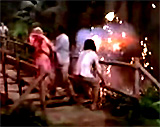
|

|
Das Boot (1981, W. Ger.) (aka The Boat) Writer/director Wolfgang Petersen's harrowing and nerve-wracking, claustrophobic thriller was one of the greatest war films (also categorized as a disaster film) of all-time. It was set on a claustrophobic, disaster-plagued German U-Boat during the early years of World War II. The horrors of being trapped in the U-96 submarine were conveyed by a Steadicam moving camera through the narrow passageways of the sub and by tightly-composed shots. It was nominated for six Academy Awards, none of which it won. The major set-piece was when the malfunctioning, aging sub was surrounded by British ships. The crew raced through the narrow tube to their stations as the sub dove deep, during an emergency free-fall dive. There were the first indications that the submerged aging structure was no longer functioning properly - it was feared that it would start leaking due to the powerful underwater pressure, signaled by excruciating groans and moans and rivets popping and blasting like gunshots. In the suspenseful sequence, the crew was able to get the sub's engines running in order to rise from a dangerous depth of 280 metres just before their oxygen ran out - and the crew's jubilation:
|
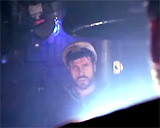  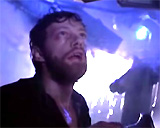
|

|
The Day After (1983) (TV) This was one of the better made-for-TV movies, and one of the best-known, most-uncompromising nuclear holocaust films ever made. The ABC-TV program drew more than 100 million viewers in the US when it debuted in late November of 1983 - some 38.5 million households watched the show. Even currently, it remains arguably the most-watched dramatic TV movie ever. It told about the survivors of a "fateful day" - living in two Midwestern cities (Lawrence, Kansas and Kansas City, Missouri) - after a nuclear exchange of missiles between the US (the forces of NATO) and Russia (in the Warsaw Pact), and the subsequent approaching nuclear winter. In the downbeat conclusion of the emotionally-devastating show, the area had been leveled, thousands were killed, and radioactive fallout, sickness and death now threatened the few wounded survivors. Kansas City Dr. Russell Oakes (Jason Robards) stumbled through the rubble of his former home, where he found his wife's charred wristwatch. Surprised to find a family living there, he threatened: "I told you to get out of my house" - and then collapsed to his knees. The husband came over to hug and comfort him. The despairing last line was delivered by Univ. of Kansas science Professor Joe Huxley (John Lithgow) as he spoke into his shortwave radio (off-screen): "Hello. Is anybody there? Anybody at all?" as the film faded to black. The end credits began with the disclaimer:
|
  
 
|


|
The
Terminator (1984) This action sci-fi (not technically a disaster film), the first in a long-running franchise series, opened in the year 2029 in a dark, ruined post-apocalyptic Los Angeles, a scene of devastation where skeleton-like machines ruled the world. Computers had become self-aware and had united together to defeat humanity - the network controlling them was known as Skynet's synthetic (artificial) intelligent machine network, created by Cyberdyne Systems, that created assassination machines known as Terminators:
The films in the franchise included:
Writer/director James Cameron's action-packed sequel was set around the year 1995. It starred Linda Hamilton as muscular warrior-female Sarah Connor, who had been institutionalized after attempting to blow up Cyberdyne Systems. She was having insane delusions and dreams about a nightmarish, end-of-the world cataclysmic event, that would occur on August 29, 1997 (in the future). She personally experienced the fiery effects of a nuclear holocaust on a children's playground. White light ignited everything like match heads as she saw her dream self burst into flames and her skin burned away. Los Angeles landmarks were pulverized as the shockwave of the blast hit the downtown area. The howling wind blasted apart the once-human figures of bone and ash. Sarah's own figure exploded down to skeletal remains. |
     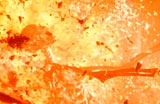
|

|
Runaway Train (1985) Director Andrei Konchalovsky's taut action thriller film (and semi-disaster film), a precursor to Speed (1994), was based on a screenplay by the Japanese director Akira Kurosawa. It was nominated for three Academy Awards including Best Actor (Jon Voight) and Best Supporting Actor (Eric Roberts). The two stars portrayed escaped inmates from an Alaskan institution, the Stonehaven Maximum Security Prison, ruled by a vengeful and mean Associate Warden named Ranken (John P. Ryan):
The two boarded a runaway train speeding along at high velocity with no brakes and also driverless (with an engineer who died of a heart attack) - on a collision course down wintry tracks in the Alaskan wilderness. |

|

|
Miracle Mile (1988) Writer/director Steve De Jarnatt's nihilistic, sci-fi noirish disaster thriller was set in Los Angeles, on the verge of an apocalyptic World War III, with an impressive, electronic music soundtrack from Tangerine Dream. The two stars were beginning a romantic relationship:
In the unlikely Armageddon scenario, Harry received a misdirected (misdialed) pay-phone call in a phone booth outside Johnie's, an all night coffee shop/restaurant at the corner of Wilshire and Fairfax. The call was from a frantic individual named Chip (presumably at an underground, secret missile silo location in North Dakota) believing he was speaking to his father with an apology. He warned of an impending nuclear apocalypse, with missiles due to obliterate the city in about 70 minutes:
Then, he heard machine gun fire, and another individual got on the phone to calmly reassure him before hanging up: "Forget everything you just heard and go back to sleep." The unbelievable phone message ultimately resulted in mass rioting in the streets of Los Angeles when word leaked of the impending nuclear apocalypse - but it was still unclear whether the frenzied panic was due to a true coming disaster or not. However in the downbeat ending, the appearance of a warhead in the sky confirmed the worst fears - and the film ended with Julie and Harry about to perish in a rescue helicopter that had crashed and was sinking into the La Brea Tar Pits! As the cabin filled with tar, he reassured her that another direct hit would turn them into "diamonds":
|
  
|
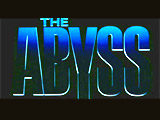
|
The Abyss (1989) Director James Cameron's big budget science-fiction rescue-mission spectacle (not officially a disaster film) was nominated for four Academy Awards, and won for Best Visual Effects. It employed both revolutionary, never-before-seen techniques and traditional effects (including miniature models, matte paintings, rear projection, and stop motion). The film opened with the quote from Friedrich Nietzsche:
In the startling opening, a credit-less title sequence, the words "THE ABYSS" emerged from the dark, and then the camera descended into the "Y" of "abyss" and then into the ocean. The sci-fi underwater adventure film told about a top-secret recovery operation during the Cold War. An American ballistic nuclear submarine, the Montana, had been ambushed and sank in deep Caribbean Sea waters (submerged about 25,000 feet down) after encountering an alien species. The crew of an experimental underwater oil drilling platform, led by foreman Virgil "Bud" Brigman (Ed Harris) and a team of Navy SEAL divers led by Lt. Coffey (Michael Biehn) investigated the sinking and made rescue attempts, when they also encountered underwater-dwelling aquatic aliens. Bud encountered angelic-looking NTI's (Non-Terrestrial Intelligences) and was taken to their awe-inspiring underwater city in a 2001-ish sequence. A famous tidal-wave sequence in the finale (approaching both coasts) was added in the restored Director's Cut of the film. A warning was delivered from the aliens to Bud and all of humanity against war-like aggression. |
    
|